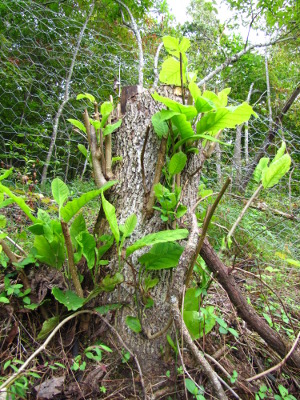
Mushroom stump and totem results
 We abruptly shifted into fall
mode a week or two ago. Cool, wet weather slows down the
vegetable garden considerably, but sends mushrooms popping out of logs
and stumps. Time to check on all of our experiments!
We abruptly shifted into fall
mode a week or two ago. Cool, wet weather slows down the
vegetable garden considerably, but sends mushrooms popping out of logs
and stumps. Time to check on all of our experiments!
Our oldest mushroom
experiment is a magnolia
stump that we
inoculated with homegrown
oyster mushroom spawn
eleven months ago. (We inoculated a box-elder stump with more
homegrown spawn this past spring.) I've read a lot about using
mushrooms to break down stumps, but I think we're going to have do some
more experimenting since I haven't seen any signs of life and think I
should have by now. The trouble is that we cut down a fresh tree
to make the stump so that it wouldn't already be colonized with "weed"
fungi, but the tree vigorously sent up new shoots! Living trees
are able to fight off invading fungi, so it's possible that we need to
find a way to kill stumps before inoculating them with spawn.
Alternatively, it might just take longer for mushrooms to pop out of a
stump compared to a log --- after all, the mycelium has to colonize all
of the roots as well as the aboveground portion of the tree before it
will make mushrooms. We'll wait and see.
 I'm pretty happy with our mushroom
totems since we harvested a big bowl full of shiitakes
Monday. True, we
didn't have any mushrooms all summer since the totem method lets our
fungi send out fruiting bodies more seasonally when weather conditions
are right. But the truth is that I've spent a lot of effort in
the past soaking mushroom logs and getting no results during the heat
of summer, and we certainly don't lack for fresh garden produce while
the mushroom totems take the summer off. I suspect mushroom
totems will last longer than the forced fruiting method of soaked
logs too.
I'm pretty happy with our mushroom
totems since we harvested a big bowl full of shiitakes
Monday. True, we
didn't have any mushrooms all summer since the totem method lets our
fungi send out fruiting bodies more seasonally when weather conditions
are right. But the truth is that I've spent a lot of effort in
the past soaking mushroom logs and getting no results during the heat
of summer, and we certainly don't lack for fresh garden produce while
the mushroom totems take the summer off. I suspect mushroom
totems will last longer than the forced fruiting method of soaked
logs too.
We're still waiting for
results on other experiments, like the new King
Stropharia bed we
started this spring and the mushroom rafts that are overgrown with
weeds and need to be weedwhacked before we can see if they're
fruiting. I'll report back when we know more, but right now we're
just enjoying our flush of shiitakes.
Want more in-depth information? Browse through our books.
Or explore more posts by date or by subject.
About us: Anna Hess and Mark Hamilton spent over a decade living self-sufficiently in the mountains of Virginia before moving north to start over from scratch in the foothills of Ohio. They've experimented with permaculture, no-till gardening, trailersteading, home-based microbusinesses and much more, writing about their adventures in both blogs and books.
Want to be notified when new comments are posted on this page? Click on the RSS button after you add a comment to subscribe to the comment feed, or simply check the box beside "email replies to me" while writing your comment.
- Remove comment
- Remove comment
